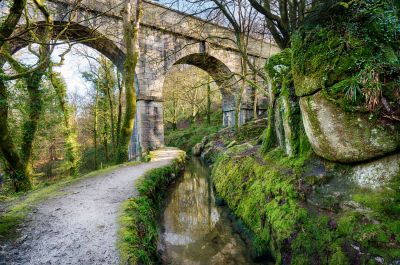
Luxulyan is a small village of granite cottages and is situated on the outskirts of Bodmin Moor in a beautiful wooded valley full of mossy granite boulders and a river rushing over rocks. Luxulyan Valley is now owned by a local charity keen to keep it beautiful, once trams and trains ran through this valley carrying locally sourced minerals for export. The rails were originally laid by the same Joseph Treffry who built the Par docks in the 19th century.
Such was the project’s standard of engineering that the impressive Treffry Viaduct, which straddles the fast flowing river Par, successfully carried water as well as rails, water which then went on to power a large water wheel. This was originally used to run a cable system which pulled wagons back up the valley, and was then used to generate electricity. The wheel itself has long since been broken up but the old gear wheels are still in existence. Though now almost completely overgrown, they serve as a poignant reminder of the thriving industry that was once here.
Nowadays the Atlantic Coast Line runs passenger trains from Par to Newquay through this leafy valley, though not over the viaduct which is now part of a network of pretty footpaths. Luxulyan is one of the small stops.
The local pub is the Kings Arms and the granite church is dedicated to St Cyriacus and Julietta, though St Sulian was abbot here during the 6th century and gave Luxulyan its name. Where the parish borders that of St Blazey in the south is Prideaux Castle, the remains of an Iron Age hill fort. The ancient Cornish clan, the Prideaux family, who held this castle in 1066 went on to build Prideaux Place in Padstow.







